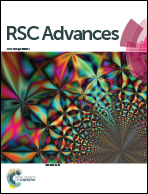Preparation of rGO/ZrP as a new adsorbent in dibenzothiophene removal from n-decane with high capacities and good regenerability†
Abstract
In this work, reduced graphene oxide (rGO)/zirconium phosphate (ZrP) nanosheets were prepared by intercalation of graphene oxide (GO) between ZrP layers followed by its reduction to rGO. Then, the adsorption behavior of the rGO/ZrP toward dibenzothiophene (DBT) was investigated. rGO/ZrP nanosheets were characterized by FT-IR, FESEM, Raman, BET and XRD analyses. The FESEM technique revealed the nano-structure of the rGO/ZrP composite and the composite has a high specific surface area of 321 m2 g−1. ZrP was used to prevent the reunion of reduced graphene oxide (rGO) during adsorption and storage, also increasing the specific surface area of the adsorbent. rGO/ZrP could decrease the DBT concentration from 500 ppmw to 322 ppmw after 4 h and the maximum adsorption capacity of DBT onto the rGO/ZrP was 46.6 mg g−1 adsorbent. The effect of desulfurization temperature, initial concentration of DBT, duration of adsorption and regeneration of the adsorbent was investigated. The DBT removal efficiency of the rGO/ZrP adsorbent was nearly constant during the five consecutive cycles of the adsorption–desorption process. π–π interactions between rGO sheets and DBT molecules are greatly enhanced due to the pillared structure of the rGO/ZrP adsorbent. Desulfurization results were very satisfactory and rGO/ZrP could serve as a promising sorbent for the removal of DBT from petroleum.


 Please wait while we load your content...
Please wait while we load your content...